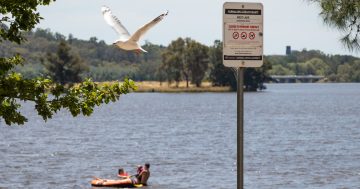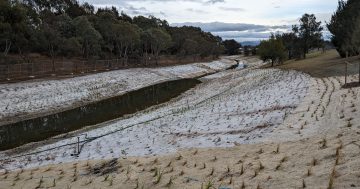
A young boy takes the plunge into Lake Burley Griffin earlier this summer. Photo: Michelle Kroll.
A toxic outbreak of bacteria and blue-green algae has closed many of Canberra’s waterways and lakes, due in part to recent heavy rainfall and run-offs from catchment areas.
Parts of Lake Burley Griffin, Lake Tuggeranong, Lake Ginninderra, Point Hut Crossing, Tharwa Bridge and Paddy’s River are all closed for swimming until further notice.
Some locations were up to 11 times the point where water is deemed unsafe.
This comes as calls have been renewed for the ACT Government to commit to a range of measures to protect our waterways.
“Unfortunately, the Parliamentary and Government Agreement hasn’t prioritised the protection of biodiversity or waterways,” ACT Region Conservation Council Executive Director Helen Oakey told Region Media.
“However, we are looking forward to the new Minister for Water, Shane Rattenbury, to advance the Greens’ commitment to invest another $30 million over the next four years to support healthy waterways, and to create a 10-year stormwater upgrade plan to handle climate change storm events.”
As of 15 January, all swimming areas of Lake Ginninderra except Bargang Beach at the MacDermott Place boat ramp are affected by bacteria and are closed for swimming but remain open for secondary contact such as sailing, canoeing or rowing.
At Lake Tuggeranong, all recreational areas are closed for swimming due to a bacteria and blue-green algae outbreak. They remain open for boating.
Paddy’s River at Murray’s Corner is closed for swimming due to bacteria, while the Molongo, Murrumbidgee and Cotter River areas are all open.
At Lake Burley Griffin, the Acton Beach ferry terminal, Central Basin, Acton West Jetty, Yarralumla Bay, Yarralumla Beach and Weston Park East are all closed for swimming. Lotus Bay, Black Mountain Beach and Weston Park West remain open.

The areas of Lake Burley Griffin closed for swimming. Image: theswimguide.org.
Lake Burley Griffin is affected by extreme levels of blue-green algae, which means swimming, diving, bathing and windsurfing are not permitted.
These areas remain open to secondary contact, but people should be careful to limit any water exposure and should shower after contact with the water.
Associate Professor in Water Science at the University of Canberra Fiona Dyer said Canberra’s lakes and waterways were highly susceptible to algal blooms and bacteria.
“Algal blooms occur when the right concentration of nutrients find their way into the catchments and they tend to sit there and stew,” Ms Dyer told Region Media.
“Bacteria outbreaks tend to be the result of recent rainfall which washes things like dog and duck poo into the catchments.”
Associate Professor Dyer said Lake Tuggeranong is particularly affected by a combination of fertilisers and rainfall runoff which causes both bacterial and blue-green algae outbreaks.
“We and local catchment groups have been working very closely with the ACT Government to try and provide really good scientific evidence for the management actions that need to be implemented.
“Also, from a water quality perspective, people don’t stop and think about what they might be doing on their own block or their little patch of ground or the street out in front of them – those areas affect water quality. And there’s a whole bunch of people who think our stormwater is treated before it goes to the water treatment plant,” Associate Professor Dyer said.

A couple of black swans in a dirty Lake Tuggeranong recently. Photo: File.
Helen Oakey also said the role of Canberra’s lakes as sediment traps is sometimes at odds with their other purpose as places for water recreation.
“We all enjoy summer days spent in our rivers and lakes, but algal blooms are an almost annual occurrence that put our favourite swimming spots out of bounds. Algal blooms come about when fertilisers, sediment and leaves run into the stormwater and then collect in the lakes, which act as holding ponds.
“When we slow the flow of water running off our gardens, parks and streets, more water is absorbed into the ground, which filters the stormwater and has the added benefit of retaining water in the soil. Including rain gardens and swales in landscaping are two ways of slowing the runoff from our gardens,” Ms Oakey said.
The health risk of exposure to bacteria outbreaks and blue-green algae include irritated skin or eyes, nausea, vomiting, diarrhoea, fever and abdominal pain. In extreme cases, damage to liver cells and nerve cells can also occur.
If you have had skin contact with affected water, immediately remove any wet clothing and wash or rinse any body part that has been in contact with the affected water.
Advice levels for all areas except Lake Burley Griffin are on the City Services website, while Lake Burley Griffin advice is on the National Capital Authority website.





















